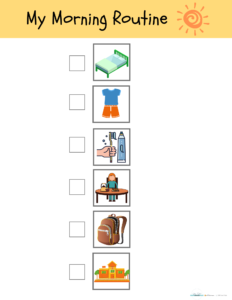Make Your Life Easier With Visual Schedules
Visual schedules are a simple way to make every day routines consistent, predictable, and structured… all things that children thrive on for success and independence.
Visual schedules (also called visuals) are a collection of pictures presented in a line that show the order a process or routine is completed in. Visuals are helpful for our children who learn best with their visual sense. The directions for a process or routine are shown in images to look at, reducing the need for the adult to verbal tell (and repeat) the direction to the child (reducing sensory overload that may affect how the child follows through on the process or procedure).
best with their visual sense. The directions for a process or routine are shown in images to look at, reducing the need for the adult to verbal tell (and repeat) the direction to the child (reducing sensory overload that may affect how the child follows through on the process or procedure).
It is important for our visual learners to see what is expected, what comes next, how many steps are included, and what “all done” looks like. Make routines simple with visual schedules.
 Support Independence and Confidence
Support Independence and Confidence
Confidence grows as the child learns the routine and begins to do it independently. The child can hang the visual in their room, near where the routine takes place, or in a centrally located place like on the fridge. They select the location which gives them control, ownership, and pride over their chart. The beauty of using visuals is that the child can be accountable to completing the routine simply by looking at the paper. There isn’t extra sensory information because it doesn’t rely on the parent each time to explain what the next step is which at times can be overwhelming and more complicated for the child.
Visuals Simplify Your Life
Think of all the routines, procedures, and processes your child has at home. Wouldn’t it be great if your child could do them independently? Putting the routines into visual form can help with that! To get started, (and without going overboard with visuals for all of them), think of a few routines that you’d like to focus on for your child. Common routines are:
- Morning routine
- Getting ready for school (could be combined into morning)
- After School
- Evening routine
Use visuals to teach a frequent sequence or procedure. You can use photographs, clipart, or hand drawn cartoons. The amount of visuals, and type of words paired with them, depend on your child’s age, development, and communication ability. The visual is a supplement to your teaching the routine. Once the child knows it, the child can follow the visual independently. Never leave a child unattended in a potentially unsafe situation.
- How to cook a meal
- How to take care of laundry (fold, hang, drawers)
- How to make a …
- How to brush your teeth, etc.
Make it Easy for You and Your Child!
I will do it all for you. You’re the expert when it comes to your child. Let’s talk!
I will create multiple personalized visuals for you to use right away in your home. Made with brightly colored images and quality materials that will last, your visuals will be ready to use as soon as you open the mail. You will have step by step directions and a video to help teach how to use the visual to your child as well as supported coaching calls to make it a smooth and personalized process for you and your family. Schedule a free chat today to learn more how to get this done easily for your child! Restore calm and build confidence at the same time. I have a variety of programs and coaching options to meet your family’s needs. Talk to you soon!
Note: There are different types of visuals commonly used for children on the spectrum in addition to visual schedules. To learn more about how to make these (and how they help), check out my new course found at stacytriplat.com and stacytriplat.teachable.com.

